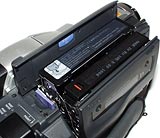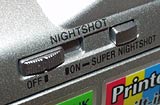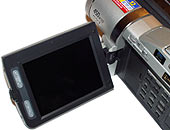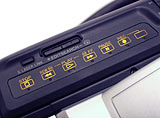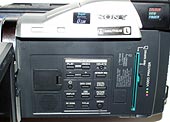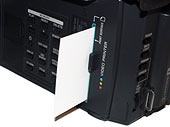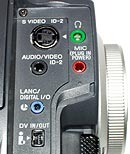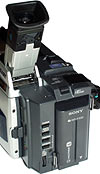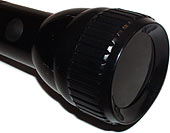
Sony DCR-TRV820E
Review date: 10 November 2000. Last modified 03-Dec-2011.
Sony's DCR-TRV820E is big, for a hand-held camcorder. It measures 112mm wide by 121mm high by 218mm long (4.4 by 4.75 by 8.6 inches). And it weighs a relatively elephantine 1.3 kilos, with no battery and no tape.
Nowadays, you can get digital camcorders that look like a compact 35mm camera turned sideways with a little lens stuck on the end.
So why should you pay $AU2,949 (US MSRP $US1399) for this relatively bloated one?
'Cos it's got features, baby. Lots of features. Big steaming piles of 'em. And one of them's, well, unique.
Allow me, if I may, to take you on the same check-out-this-cool-toy guided tour to which I have recently subjected various hapless office-mates.
The 820E is a Digital8 camcorder, which means it records Digital Video (DV) data, but on ordinary 8mm cassettes. It really wants the more expensive Hi8 or D8 tapes, but it'll work with plain Video 8 cassettes. Just don't expect cheap tapes to, necessarily, play back well on other D8 camcorders. They'll probably only look right on the one that recorded them.
To squish DV data onto 8mm tape, Digital8 camcorders run the tape at double speed. A 120 minute tape becomes a 60 minute one. The TRV820E has a Long Play mode, as well, which gives you three-quarters of the stated tape capacity instead of half. For Long Play, you'd better be using high quality tape.
The camera can also play back, but not record, ordinary analogue 8mm tapes. So if you upgrade from some other 8mm camcorder, you can still play your old tapes.
Sony make several D8 camcorders, though. So D8 is not the camera's unique feature.
Sharp-eyed viewers might notice a little purple thing sticking out vertically in front of the tape bay. That's a Memory Stick, Sony's proprietary Flash memory card format. The TRV820E can work as a digital still camera as well, dropping the images in standard JFIF (JPG) format onto the Stick.
This is also not the camera's unique feature.
The 820E's zoom lens is a 48 to 1200mm equivalent, in 35mm camera terms. The teeny CCD image sensor means it's actually a 3.7 to 92.5mm lens - the smaller the image sensor, the smaller the lens focal length for a given field of view - but don't mind that.
The maximum wide-angle setting isn't as wide as you get from many still cameras, but that's not a big deal for a video camera, because you can just pan to get everything in.
The zoom, however, is superb. You get a lot more of it than you'll get from a teeny-weeny palm-sized camcorder, the best of which manage about 12X. There's subtle pincushion distortion at the full wide-angle setting, but it's hardly noticeable, and it goes away as you zoom.
On top of the highly respectable 25X optical zoom - which, by itself, can blow up the full moon until it's a hair under a third as wide as the screen - there's digital zoom, which can be set to give you a total combined zoom figure of 50X, or a rather ridiculous 450X.
Whacko - a 21.6 metre lens! Call the papers!
Of course, the digital zoom turns into lumpy pixel-garbage at high magnification levels, because it doesn't magically add resolution to the CCD. You're just looking at a smaller and smaller piece of the CCD image when you use digital zoom.
That said, the more modest 50X setting isn't too bad. The extra zoom is nice to have for framing an image, and the loss of image quality from a 2X digital zoom isn't too revolting. Since the camera has a digital image stabiliser, the high zoom settings are useable even without a tripod.
But none of this is unique, either.
The lens has a 37mm filter thread on its end, so you can put your special effect or teleconverter or whatever other gadgets on it.
Ain't nothin' unique about that.
The TRV820E can also see in the dark. It's got a "NightShot" switch that drops the camera's IR filter, allowing it to see near-infrared light.
This is not the same as seeing heat. Heat is far-infrared, and you need a different kind of sensor to pick it up. Just as the UV light from a blacklight bulb won't give you a suntan (or cancer, for that matter), near infrared is not hot. But it's invisible to the naked eye.
If you're in a well-lit environment, NightShot still gives you a colour picture, though it's a lower contrast, washed-out one. Go somewhere really dark, where most camcorder can't see a thing, and you'll see a surprisingly well-lit greyscale view of nearby options.
This is because the 820E has a couple of IR illuminator LEDs, lurking behind the dark-tinted plastic cover at the bottom of the front, beneath the stereo microphone grille. You can't see through that plastic, but it's transparent to infrared light.
One LED's a wide-angle illuminator, one's more tightly focussed; between them, they give you a black and white image about as well lit as you'd expect it to be if you'd strapped a good two-AA-cell torch to the side of the camera. You can boost the sensitivity at the cost of frame rate by pressing the Super NightShot button.
NightShot's certainly unusual, but, again, it's not unique.
There's a remote control, for easy playback and self-filming purposes.
Which is far from unique.
Like many current camcorders, the 820E has an LCD viewscreen in addition to its colour viewfinder. The screen has a generous 10cm diagonal (almost four inches), and 560 by 220 resolution, with volume and brightness controls on one side of it. It gives you a good idea of what you're looking at, unless you're in full sunlight. In that case, the viewfinder's better.
The screen hinges out 90 degrees and can rotate 270 degrees, so it can face back, straight down, straight forward, or face outwards from its stowed position on the side of the camera, if you like. Whenever the screen's rotated so that the image is upside down, it automatically inverts the picture so it comes out the right way up.
The facing-forward screen position's particularly handy for one-person-bands wanting to do a piece to camera.
But none of this is unique, either.
Put the camcorder in VTR mode and its playback controls, on the lid of the tape bay, light up. Not unique.
The camera also features Sony's Super Laser Link system; with an optional receiver unit, you can send video and audio from the 820E in VTR mode to your TV, with no wires. All it needs is line of sight for its infrared data link.
Which is pretty swish, but also not unique.
This is the side control panel that's revealed when you fold out the screen.
Observe, if you please, the green slot towards the back of it.
That's where you put the paper.
And your photo prints come out here.
That, ladies and gentlemen, is the unique feature.
I'm reasonably sure that this camera also has a corkscrew and a thing for taking stones out of horses' hooves in there somewhere, but I haven't found them yet.
Printing!
Now that I've got you all a-tingle about the 820E's nifty extra feature, settle. It's not that exciting.
For a start, the prints are really small. The special paper is only 91 by 55mm in size, and the printed area's only 64 by 48mm.
And you can't fit a colour ink jet engine into the bum of a camcorder. What you get instead is a thermal dye-sublimation printer, which uses a sequential four-colour plastic ribbon with pigment on each section, which is flashed to vapour by the print head and recondenses on the paper. The paper makes four passes, on each of which one more of the cyan, magenta, yellow and black pigments is laid down. And then the print emerges in all its glory.
The dye-sub printer's got 254 dot per inch resolution. This sounds pretty good, but the prints are so small that you only get 640 by 480 printed resolution. Then again, 640 by 480 is all the 820E can capture in still image mode anyway.
Printing with the 820E is fiddly. You have to feed the paper in one sheet at a time, and if you don't push it in far enough the printer won't grab it. The paper hangs out of the green input slot, which is next to the LCD screen latch, so it stops you from closing the LCD screen.
It's possible to do real-time, Polaroid-style photography with the 820E, without recording anything to tape or Memory Stick, but you have to frame your shot with the LCD. The paper stops the LCD from closing, and the viewfinder doesn't work when the LCD's open.
When I fiddled my way into actually starting a print operation, the Print Cartridge light merrily flashed at me to tell me that the last person to use the camera had used up all of the print ribbon and Sony, in their wisdom, hadn't installed a new cartridge. I had some paper, but no pigment to put on it.
Well, maybe there was something else wrong with the cartridge; I don't know. But since each cartridge is good for only 20 prints, it wouldn't surprise me if this one was used up.
Luckily, some previously made prints came with the review camera. They look OK. Not exciting, and with the oversaturated look of many video prints, but they'd do for ID pictures or child-pleasers.
According to the manual, the 820E takes a hefty 150 seconds to print its teeny pictures. This isn't unusual for a dye-sub printer like this; they're not renowned for their speed, but they were the only option for vaguely economical digital photo printing before inkjets got as good as they are today.
Sony's CPPM-NR40 print pack gives you 40 of the little sheets of paper and a pair of print cartridges to match, and costs about $US20. The cartridges are very easy to change, but wow - I thought consumables for my Stylus Photo 1270 were expensive.
For $US10 more, you can get a pack with 20 sheets of sticker paper and 20 sheets of multi-sticker paper, and another pair of ribbon cartridges. The multi-sticker sheets have nine little stickers per sheet, which neatly matches the nine-image thumbnail view and print mode the 820E offers. This could be useful if you need to make ID badges and suchlike, but the stickers are so tiny that I think it's got to be a pretty small niche market.
The camera comes standard with a combo paper pack - 20 plain sheets, 10 stickers, 10 multi-stickers, and two ribbons. Fortunately, there's another version of this camera, the DCR-TRV720E, which is exactly the same but doesn't have the printer. It lists for only $US100 less than the 820E - maybe $AU200 less - but that money would still be better put toward a photo quality ink jet printer for your PC, unless you've got some remarkably good reason to want to make weeny prints in your camcorder.
The 720E, though, doesn't seem to be available in Australia - or, at least, Sony Australia don't have it on their Web site.
Image quality
The 820E's single CCD has an effective resolution of only 400,000 pixels. 640 by 480 pixels is only 307,200, of course, but there are lots of DV cameras with considerably better resolution, and it makes a difference.
Digital8 cameras don't take DV tapes, but they record DV data. DV is a digital format, so it has a definite resolution - 720 by 576, for PAL, for 414,720 total pixels per frame. That's its luminance (brightness) resolution, though; its chrominance (colour) resolution is only 360 by 288. Think of it as a sharp greyscale image tinted by colour tiles twice the size of the grey pixels.
This is a standard data-reduction technique, because the human eye sees luminance more sharply than it sees chrominance - there are more rod cells than cone cells in your retina.
Every image format that needs to fit as much data as possible into a limited file size or transmission bandwidth uses lower chroma resolution. JFIF (JPG) and MPEG files do it, and so do all of the analogue television standards, for instance.
But just because your digital video format has a nice clear resolution (as opposed to analogue formats, which have a nice clear number of lines and a very hard to define number of columns...) doesn't mean that the data you're storing on your tape is actually making use of all of that resolution. You can connect a DV tape recorder to the output from a dinky colour security camera, and the result will be the fuzzy mush you'd expect.
Now, from the pixel count you'd think the 820E would pretty much exactly fill DV resolution and look just fine. And it does look just fine, generally, but it could still do with some more CCD pixels, for two reasons.
First, this is a single CCD camera. The individual light sensing units on the CCD don't actually detect colour; they just detect photons. To get a colour image, there's a pattern of coloured filters over the light sensors, and the colour of each pixel is figured out by looking at its differently-filtered neighbours' opinions. Which means you lose a little detail.
Now, since chroma resolution's lower than luma resolution, this isn't as much of a problem as you might think. But it's still there. More expensive camcorders use three CCDs, one each for red, green and blue, to avoid it.
The second reason why the 820E needs some more resolution is its digital image stabilisation.
Sony's "Super SteadyShot" is not one technology; it's just a label they stick on anything they currently make that's got some sort of image stabiliser.
On some devices, like the highly unusual MVC-CD1000 digital camera I review here, Super SteadyShot is optical image stabilisation. This near-magical technology uses little accelerometers to figure out how the camera's moving, and a fluid-filled prism with movable front and rear faces that actually steers the image onto the CCD, keeping it as steady as it can. It is spookily effective.
All digital image stabilisers, on the other hand, do their thing by moving a viewing window around on the actual CCD output data. The window movement's determined by electronics that try to minimise the rate of change of the image.
Jerk the camera left, and the window moves right to compensate, then creeps back when the camera comes to a halt.
This is all very well and requires no moving parts, but it means you don't get the full CCD resolution.
The TRV820E's stabiliser can be quite obnoxious, for indoor shooting. Outdoors in daylight, it works great; there's very little perceptible image resolution or quality loss. But in even brightly lit indoor situations, the stabiliser adds noticeable noise to the image, unless you use one of the frame-rate-reducing sensitivity enhancement modes. This isn't resolution-loss grain, it's twinkly noise.
With a higher resolution CCD, the image stabiliser window could be full DV resolution and there'd be no problem. It isn't, so there is. This isn't a giant crippling handicap, but it's annoying.
Connections
A pop-off panel in front of the tape bay covers the various ins and outs.
You get an S-Video Y/C connector and a 1/8th inch jack that serves as a combo composite video and stereo audio connector. Both work as outputs or inputs, depending on the camera mode. You get the 1/8th inch to triple RCA plug lead in the box, but not an S-Video lead.
There's a headphone socket and an external microphone connector; you can install a better microphone in the mounting shoe at the front of the camera, if you like.
There's a "LANC/Digital I/O" jack as well. Also known as Control-L, this lets you connect the camcorder to a computer or other edit rig with a serial port, and control the basic playback and tape movement functions remotely. You get a LANC cable in the box, too.
The most important connector, though, is the little "i.Link" one at the bottom.
I.Link is Sony's version of IEEE-1394, the interface which Apple, who invented it, call FireWire. IEEE-1394 was, pretty much, created to move DV data and control DV devices. You can use 1394 for regular computer storage devices and all sorts of other peripherals as well, but it was introduced when DV was introduced, and its low-level data transfer structure neatly matches DV's storage structure.
I.Link is 1394 minus the power supply capability. I.Link devices must all have an external power supply, and can't run from just the i.Link cable.
This doesn't matter at all for camcorder purposes, since the i.Link port is there purely so the camera can connect to some 1394-capable video recording or editing device, and send and receive beautiful zero-loss digital video.
You get digital output even when you're playing an analogue tape, by the way. It doesn't make the analogue video look any better, but it lets you play it straight into your non-linear editing package. And, of course, you can record analogue input video onto D8 as well.
Sony don't provide any video editing software with the TRV820E - or even an i.Link cable - but they do give you PictureGear v4.1 Lite, a thoroughly unremarkable Windows image and movie filing and thumbnailing and slideshowing program. If you've already got an image viewer installed, PictureGear is unlikely to set your world alight.
Documentation
The English/Russian (seriously!) manual for the 820E is OK, but not great. Despite their world-girdling might, Sony are still not the kings of clear idea expression in their product docs.
When you've actually got the camera in front of you, though, it doesn't take long to figure out the operations the manual obfuscates. And it's not as if there's another electronics manufacturer that gets P.J. O'Rourke to write their manuals, or something.
Fortunately, the manual still contains that old Sony standby - warnings not to do patently goofy things. Like carry your camera by the battery, the viewfinder, or the LCD screen.
Personally, I think those components should have big luminous "NOT A HANDLE" stickers on them, but that's just me.
Using it
In use, the 820E is your basic camcorder with knobs on. Image quality is excellent - when the image stabiliser isn't monkeying with it - and the user interface is pretty good, too. The camera is pleasingly free of little niggles.
The rear view.
The viewfinder can slide back and hinge up - the picture shows its backmost, uppermost position - so persons with the largest of schnozzes can use the camera without rubbing their proboscis on it. There's also the usual dioptre adjust lever under the viewfinder, so its focus can be set properly for various users, including eyeglass wearers.
The battery on the camera in this shot is the stock 7.2 volt NP-F330 700 milliamp-hour unit. It's one of Sony's own expensive InfoLithium batteries, that reports its exact charge state to the camera. This lets you see the remaining run time at whatever current draw you're presently demanding from the battery.
Even with LCD use and similar fooling around, you should get at least an hour of run time out of the little battery, and probably a fair bit more. Maybe 100 minutes, with no LCD use.
If that isn't enough, there are three optional higher capacity batteries, the biggest of which is the NP-F960 ($US150 MSRP...), which gives you 5400mAh capacity. That's nearly eight times whatever run time you'd get with the little battery.
The AC adapter plugs into a socket, covered with a little rubber flap, beneath the battery. You can use the camera without a battery when the adapter's plugged in, but the battery only charges when the camera's turned off.
While the camera's on charge, a small LCD display on the outside of the main LCD viewscreen lights up and tells you the charge state, including how many minutes of run time the camera thinks it's got. The little display's usual purpose is showing the tape counter.
There's a clickable selector wheel on the bottom of the back of the camera that you use to make menu selections - roll up and down to pick the option you want, push to select. It's better than a three-button menu selector, but worse than the clickable-joypad alternative.
The wheel redeems itself, though, for exposure selection. You use it to cycle through the various auto-exposure and manual exposure adjust modes, and it's especially good for the latter adjustment.
Like other DV cameras, the 820E can record still images to tape as well as to its Memory Stick. Tape-recorded still images are just the one frame repeated for seven seconds, with accompanying audio, but you can certainly get a lot of them on one tape.
Memory Stick images are 640 by 480 JFIF (JPG) files. There's a choice of two compression modes, Fine and Standard, which squish the images down by a factor of about six and a factor of about ten, respectively. Fine images are about 100 kilobytes, Standard images are about 60 kilobytes. So even with the stock 4Mb memory stick, you can record a respectable number of photos.
The cycle time for storing a Fine quality image is about three seconds - it takes three seconds before you can take another shot. This is on par for cheapo digital cameras with no buffer memory.
The 820E's still resolution might not be impressive by current standards, and there's no flash, but the giant zoom and excellent low (and no) light performance helps a lot. As a digital still camera, this is a strange one, but it's not a useless one.
Image modes
The 820E's got a 16:9 widescreen mode, which letterboxes the viewfinder display and records width-compressed video to the tape. It's not magic, of course; you only get the middle three-quarters of the CCD's resolution when you're in widescreen mode, so you may have a cinematic aspect ratio, but you've got less resolution.
There's a multi-mode in-camera fade/wipe function, which gives you six ways to splice together your separate blocks of video. There's also the usual assortment of in-camera "Picture Effects", which aren't useful for much. Black and White, Sepia, horizontal and vertical stretches, big-pixel Mosaic mode, Pastel, Solarise and the old faithful Negative are all there, and all as pointless as ever.
There's also, though, a selection of "Digital Effects" which are more impressive, if still not terribly useful overall.
"Still" lets you grab a snapshot of whatever the camera's pointed at and, with the control wheel on the back, control how opaque it is, and how much moving video shows through.
"Flash Motion" is the strobe mode (also known as the "make people look as if they can dance" effect), but the control wheel lets you pick the strobe rate you want.
"Luminance Key" grabs a picture, like Still, but subsequent video shows through only in the brightest areas of the picture, and the control wheel lets you set the cut-off point.
"Trail" does multiple consecutive translucent Still effects, for a trippy the-LSD-scene-in-Easy-Rider look. The control wheel selects the intensity of the effect.
"Slow Shutter" lets you manually reduce the shutter speed, increasing low light sensitivity as you go. It's a manually controllable low-lux mode, and it might therefore actually be quite handy.
"Old Movie" letterboxes the screen, sepia-ises it, and drops the frame rate, for that Charlie Chaplin appearance.
There are plenty of special auto-exposure modes. "Spotlight", for brightly lit people against a dark background; "Soft portrait", to reduce depth of field and blur distracting backgrounds; "Sports lesson", that picks a high shutter speed to keep fast-moving things sharp; "Beach and ski", that does the opposite of Spotlight, compensating for bright backgrounds; "Sunset and moon", that stops the camera from brightening scenes that you'd rather leave dim and romantic; "Landscape", that stops the camera from focussing on nearby things; and "Low lux", that provides a plain colour stutter-vision low-light mode, separate from the NightShot mode.
It's NightShot that's likely to sell at least a few of these cameras. But not to the sort of people with whom most of us would enjoy being trapped in a lift.
NightShot nasties
You can disable the 820E's built-in IR illuminators if you like, if there's some other source of IR light nearby.
Like this, for instance. This is the shiny end of my six-D-cell Maglite - the giant, unwieldy one for which you can buy a baton handle if you want to give up on even the pretense that it's not at least partially meant to be used for clubbing people into insensibility.
Over the lens is an IR filter, which blocks almost all of the visible light output and turns the torch into a pretty darn good IR illuminator. To the naked eye, it's a very dull red glow; to the TRV-820E or anything else that can see infrared, it's as bright as you'd expect the unfiltered torch to be.
Sony have their own IR illuminator, too - the HVL-IRH2 - that clips into the accessory shoe on the camcorder.
Apropros of which, let's talk about perverts.
There are people in the world who never quite grew out of their desire to own something that was exactly like those X-Ray Specs advertised on the back of comic books, except that it actually worked.
Those people have had a deep and abiding affection for NightShot camcorders, ever since Sony released the first such gadget, the DCR-TRV9. The TRV9, and a handful of other NightShot cameras, could do IR-only NightShot even in bright sunlight.
This is nifty, for the small group of people who want to do infrared daytime photography.
But the 820E, and other current NightShot cameras, now can't do IR-only NightShot. There's a reason.
Y'see, some fabrics - sheer synthetic ones, like "tan-through" bathing suits - are transparent to near infrared. Switch to NightShot mode, with decent IR illumination from one source or another (bright sunlight will do), and you can see through the fabric. Ooh la la.
Most fabrics, of course, are as opaque to IR as they are to visible light. And if there's nothing shooting adequate near-infrared light at your target, it'll be dark. But the sun is a good IR illuminator. And so the dirty-raincoat brigade bought a lot of NightShot camcorders, and spent a lot of time wandering around trying to find something naughty to see with them. News stories resulted.
And Sony got embarrassed, and removed the IR-only NightShot feature.
So the pervs moved on to IR-pass filters, which block everything but infrared. Put one of those on your camcorder and put it in NightShot mode in daylight, and as far as the camera's concerned it's dark, but there's a heck of a good infrared illuminator hanging in the sky. The ooh-la-la-ing thus continues.
Apparently, the daylight NightShot prevention feature on at least some Sony cameras simply amounts to blocking the exposure controls when NightShot's engaged. The 820E, indeed, doesn't let you do a thing with the exposure settings when it's NightShooting. Disable the little switch that tells the camera to do that, and Naughty Mode, I'm told, is back.
I, like, totally don't have the energy to open up the 820E and find out if it's got one of these little switches or not. I leave it as an exercise for the reader.
Some kinkoids, seeking to get naughty mode back without performing surgery on their cameras, accidentally buy the wrong kind of IR filter. They get a normal IR filter, which is exactly what they don't actually want.
Your normal IR filter, also known as a "hot mirror", is a useful thing for ordinary non-voyeuristic camcorder users. Hot mirrors block infrared light.
Pretty much all camcorders can see near-IR, because all CCDs can, and the internal IR filters, if they're there, often aren't as good as they might be. The CCDs can in fact see IR so well that if there's a lot of it about on a bright sunny day, you'll get a blue cast to your video. Digital still cameras do the same thing.
Film cameras have exactly the opposite problem. Normal film has poor sensitivity to IR, but good sensitivity to ultra-violet - off the visible spectrum again, but at the other end.
So if you've got a film camera, you stick a UV, or "skylight", filter on it, to keep the excess blue out of your outdoor pictures.
Hot mirror filters are more expensive than UV filters, though, by quite a wide margin.
For this reason, you actually see quite a lot of CCD-equipped devices with UV, not IR, filters on them. My own digital camera wears a UV filter all the time. They're just there because they're practically the cheapest filter you can buy, and they stop the lens getting scratched. That's all they do on a CCD gadget, but it's a very worthwhile function if you've got an integrated-lens digicam - if the lens gets damaged, you generally can't economically repair the camera.
Getting back to hot mirrors, though - to recap, they block IR. So if you want to see IR, as you lurk in your panel van pointing your high-zoom camcorder through the nurses' college dorm window, putting an IR filter on the thing is the very last thing you want to do.
Nonetheless, more than a few potatoheaded perverts buy hot mirror filters like they're going out of style. Camera store employees happily sell the filters to them, too, because they know most of them will be too embarrassed to ask for a refund.
Overall
If you want a small-ish camcorder with everything including the kitchen sink, this is pretty much it.
But it doesn't have fabulously high resolution, and it's not cheap; if you're considering paying this much money, there are various MiniDV options as well. You might be happier with a smaller camera, or a cheaper one. If you don't care about digital recording, Hi8 cameras give excellent image quality for less money.
Video 8 tapes are much cheaper and easier to find than MiniDV or even Hi8 ones, so Digital8 wins for convenience and value if you're travelling the world. And if you've got an existing 8mm tape library, D8 camcorders are obviously superior.
You don't lose anything in record time versus MiniDV - the longest MiniDV cassettes commonly available are 60 minute, or 90 minute in long play mode. Panasonic makes an 80 minute MiniDV, but by and large the 60 minute record time a D8 camcorder gives you on a 120 minute 8mm tape is par for the course for small cameras. MiniDV cassettes make 8mm ones look huge, but neither is exactly a storage nightmare.
Unless you want one small object that can be used to make ID badge stickers, or have some other reason why the slow, small printer in the 820E is invaluable to you, the TRV720E is, I think, a better product. Cheaper, but with the same great zoom and good LCD screen and NightShot and so on. But I don't know if you can get it in Australia.
And, of course, the 720E doesn't have anything unique.
Sony had better make a version with a moose call built in, or a grenade launcher, or something, to help hold the attention of the gadget-freak market.
Given that you're not spending a zillion dollars for the 820E's underwhelming printer, and also given that it doesn't add five kilos to the weight of the camera, it's not really a huge handicap.
As long as you know what you're buying, and don't expect photo quality A3 prints in 20 seconds, this is a great camera. Well worth checking out.
Review DCR-TRV820E kindly provided by Sony Australia
Sony's page for the DCR-TRV820 (the NTSC version of the 820E)

